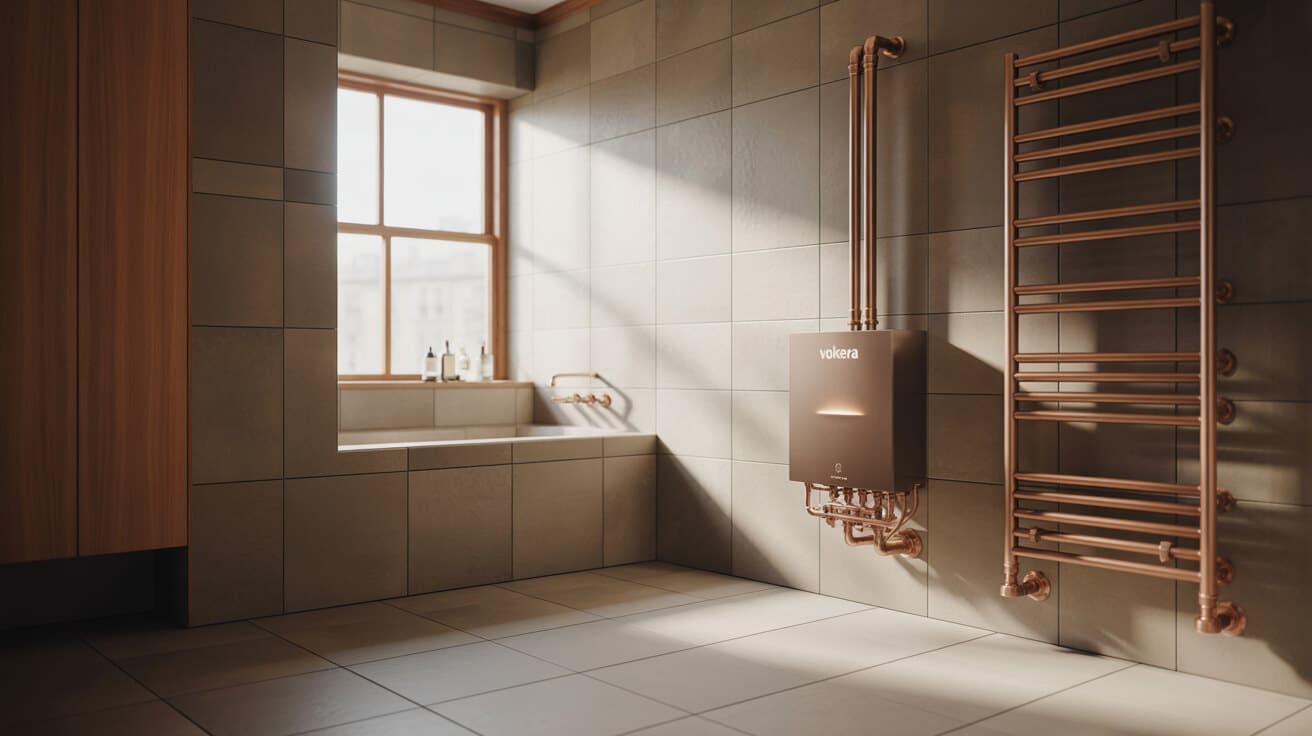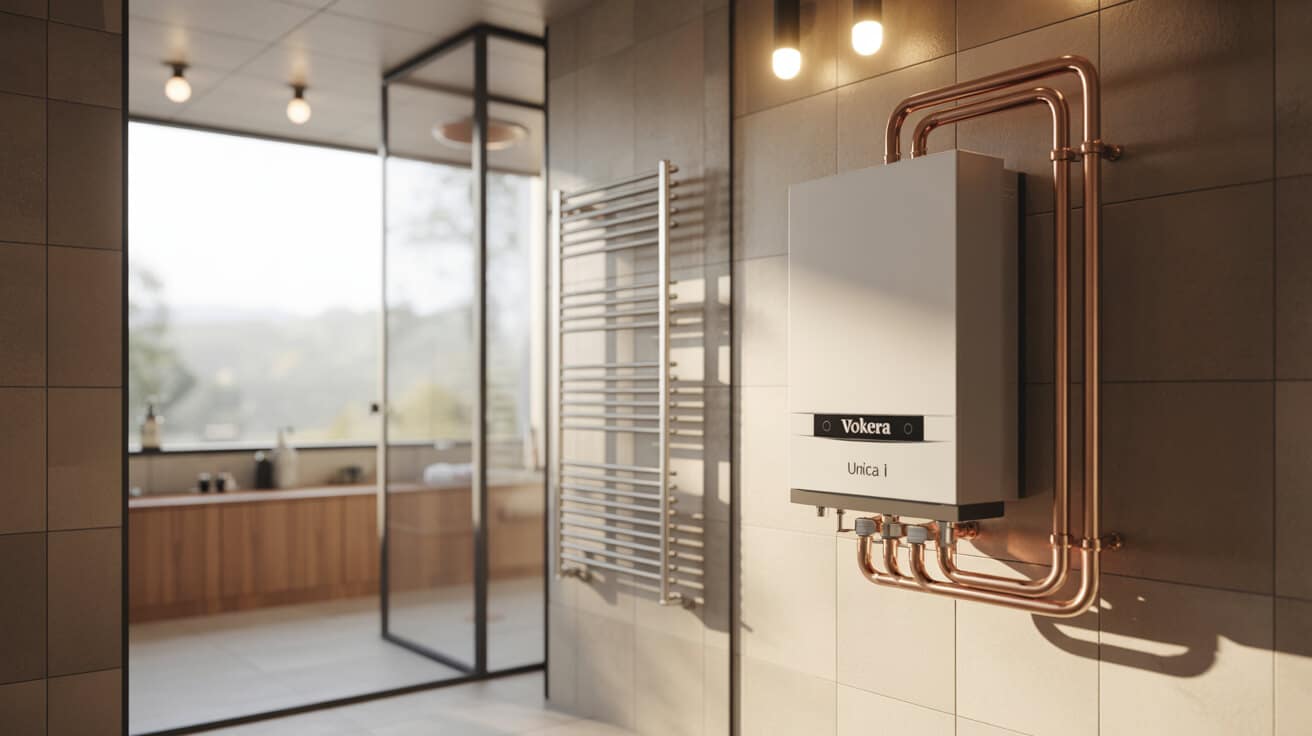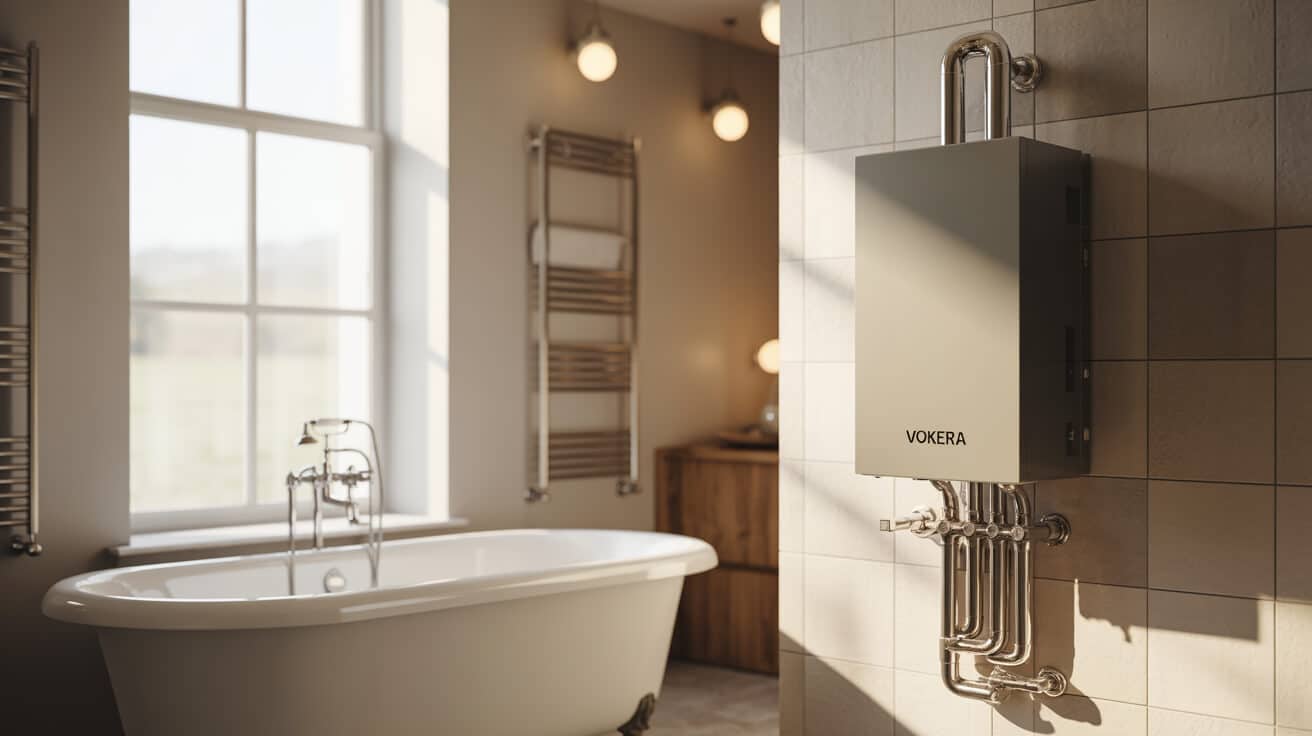The Unica i range delivers advanced heating and hot water capabilities to a spectrum of properties, supporting energy-saving objectives and reduced emissions in line with recent legislative changes in the United Kingdom. The appliance’s architecture—encompassing stainless steel heat exchangers, digital modulation, adaptive burner systems, and compatibility with the OpenTherm protocol—enables flexible deployment across renovation, replacement, and new build contexts. As regulatory and customer standards have advanced, Unica i has established itself as a reference point for compliance-focused, high-performing heating solutions, favoured in the market for its reliability, lifecycle economy, and support for digital management.
Etymology or Name Origin
The name “Unica i” synthesises brand strategy and technological evolution. “Unica,” derived from the Italian for “unique,” positions the product as distinctive in Vokèra’s broader portfolio, drawing on the parent brand’s longstanding relationship with Italian engineering principles. The “i” denotes the intelligence and innovation infused in this generation of the product line—signalling the integration of enhanced electronics, user-facing controls, and compliance upgrades. Vokèra, from the Italian “vocare” (“to call”), alludes to the company’s original commitment to customer responsiveness and adaptive technology in heating appliances. Market nomenclature for the Unica i adheres to standard conventions in the sector, using alphanumeric markers to distinguish lineage and features within evolving product lines.
Overview / Context
Market Position and Adoption
The Unica i series is situated in the mid- to upper-tier range of the condensing boiler segment. Recognised by professionals and end-users for its balance of advanced functionality and cost-effectiveness, it targets property owners and commercial asset managers seeking energy-efficient, low-maintenance solutions. Legacy models from Vokèra capitalised on simplicity and dependability; the Unica i range extends this tradition, delivering enhanced compatibility with digital controls, increased warranty coverage, and robust service support.
Its targeted versatility ensures suitability for traditional two-up-two-down housing, compact apartments, and larger family homes—all common profiles within the UK and Irish housing stock. Property managers and landlords select Unica i to ensure legal compliance, comfort for tenants, and ease of scheduled maintenance. Plumbers 4U routinely specify and fit the Unica i for both individual homeowners and large property portfolios, integrating it into annual maintenance and energy-saving upgrade programmes.
Role in Central Heating Evolution
Current expectations for heating systems prioritise emissions reduction, lifetime performance, and seamless digital integration. Unica i directly addresses these requirements by offering agile load response, modulation to match property demand, and integration with third-party smart thermostats and weather compensation modules. This supports the transition from analogue, manually adjusted boilers to automated, remotely controlled environments valued by tech-oriented clients and energy-conscious landlords.
Prevalence in Contemporary Installations
Retrofitting ageing housing stock for regulatory or client-driven improvements remains a substantial market. Unica i’s approval for installation in both sealed and open vented systems, its flexible flue options, and its standardised commissioning process allow it to fit within numerous construction and occupancy models. Its presence in national upgrade schemes and private renovations has cemented it as a go-to model in the competitive landscape of gas-fired boilers.
History
Brand and Early Development
Vokèra’s origins trace to the Riello Group’s strategic expansion into the UK heating market in the late 20th century. Initial imported product lines emphasised reliability and compliance, attributes necessary to compete in a landscape shaped by rapidly evolving gas safety and environmental regulations. Vokèra’s engineering integration with British standards and development of a dedicated UK service infrastructure elevated brand trust among both trades and end users.
Technology Milestones
The advent of Condensing Boilers represented a significant step change, prompted by incremental tightening of building and efficiency codes. The earliest Unica models responded with improved heat exchangers, condensing modules, and service-facing diagnostics. Digital user interfaces, always a distinguishing feature in Vokèra’s brand storey, evolved into more data-rich, programmable displays. Enhanced burner technology for modulating output established the foundation for precise heating control now associated with the Unica i line.
Integration with Regulatory Changes
Regulatory improvements such as the ERP directive and Boiler Plus imposed stricter requirements on efficiency, embedding controls, and emissions. Vokèra’s product iterations kept pace, culminating in the Unica i’s expanded compliance with NOx Class 6, ERP Class A, and integration with smart zoning interfaces. Recent models have leveraged digital diagnostics, electronic safety interlocks, and cloud compatibility to ensure ongoing alignment with industry governance and certification.

Concept / Description
Physical and Technical Characteristics
Unica i boilers are compact, wall-hung appliances available in multiple power outputs, typically 20, 25, 28, or 32 kW (heating output). The chassis is built for discreet installation, with service hatches, insulated panels, and corrosion-resistant internals spec’d for longevity and quiet operation. The central heating assembly comprises a stainless steel heat exchanger for robust thermal transfer, modulating fans, a sealed combustion unit, and high-efficiency pumps. Pressure and temperature sensors, as well as a digital LCD panel, allow real-time monitoring and precise system adjustment.
Key Internal Components
- Heat Exchanger: Made of stainless steel for durability and high-efficiency heat transfer.
- Burner Assembly: Pre-mixed, low-NOx burner integrated with advanced modulation control.
- Pump: Low-energy, variable speed to support both regular and underfloor circuits.
- Expansion Vessel: Built-in, typically set between 7 to 12 litres, sized to system capacity.
- Safety Controls: Integrated pressure relief valve, automated bypass, and anti-legionella protocols.
User Interface and Smart Controls
A prominent feature of Unica i is the backlit LCD display, which provides operational status, service reminders, and, when relevant, error/fault codes for easier troubleshooting. The platform is compatible with OpenTherm devices, facilitating integration with market-leading thermostats such as Nest, Tado, and proprietary BeSMART systems. This connectivity enables remote scheduling, temperature zoning, and, in some property contexts, remote diagnostic transmission to service providers.
Integration Possibilities
Unica i supports multiple flue arrangements, allowing for rear or top exits tailored to onsite requirements. Third-party system accessories—weather compensation sensors, zone control relays, unvented cylinder kits—extend adaptability. For advanced deployments, system versions align with indirect hot water cylinders, multi-zone underfloor heating arrays, and hybrid integration with renewable pre-heat sources.
Functionality / Purpose / Applications
Heating and Hot Water Functions
Combining heating and hot water provision in a single appliance, the Unica i servestwo central needs: space heating via radiators or underfloor pipes and on-demand domestic hot water (DHW). Combi models deliver hot water directly via internal heat exchange, eliminating the need for separate storage, while system configurations work in conjunction with storage cylinders to provide higher output for larger dwellings or properties with multiple bathrooms.
Control Logic and Energy Management
The modulation logic enables the appliance to use only as much energy as required at any time, reducing waste and maximising cost savings for your property. Digital and programmable thermostats—along with weather compensation—allow owners and managers to tailor heating to occupancy and outside temperatures, a key driver of both comfort and energy conservation.
Service Scenarios and Deployment Types
- Owner-Occupied Homes: Delivers direct, responsive heating and hot water using main gas supply, easily programmed to suit your routine.
- Landlord Portfolios: Systemized installation and annual servicing meet legal compliance, maintain warranty, and support positive tenant experience.
- Property Managers/Developers: Scalable specification and documentation, including digital warranty records, facilitate cost-reduction and asset management across multiple sites.
- Installers: Rapid commissioning, clear display-driven set up, and extensive technical support make Unica i conducive to process-driven service delivery.
Classifications / Types / Variants
Combi Boiler Models
- *Unica i20 Combi*: 20 kW output, suitable for small to medium single-bathroom dwellings.
- *Unica i28 Combi*: 28 kW output, serves mid-sized homes with moderate DHW demand.
- *Unica i32 Combi*: 32 kW output, supports larger houses or properties with higher hot water consumption.
System Boiler Models
- *Unica i25 System*: Combines high-efficiency heating with compatibility for separate hot water cylinders; supports multiple-bathroom or high-demand sites.
- *Unica i32 System*: Delivers robust heating for larger system installations, including multi-zone or hybrid renewable systems.
Feature Differentiation Table
| Model Type | Output (kW) | Hot Water Flow Rate (l/min) | Integration | Application |
|---|---|---|---|---|
| Combi 20 | 20 | ~10.5 | Direct DHW | Smaller homes |
| Combi 28 | 28 | ~13.3 | Direct DHW | Standard homes |
| Combi 32 | 32 | ~14.7 | Direct DHW | Larger dwellings |
| System 25 | 25 | Cylinder-dependent | Cylinder | Multi-bathroom |
| System 32 | 32 | Cylinder-dependent | Cylinder | Large homes/multi-zone |
Systems / Tools / Methodologies
Standard Installation Workflow
- Site Assessment: Evaluation of property heat load, existing pipework, gas supply, and flue exit points.
- Preparation: Secure wall mounting with allowance for service panel access and pipe set orientation.
- Connection: Integrate gas, water, and electrical circuits, configure flue, and fit condensate drainage to external or internal points.
- Commissioning: Fill and pressure test system; parameterize controls; perform flue gas analysis; record in benchmark logbook.
- User Familiarisation: Demonstrate basic interface features, programmer use, and visual indication of system status.
Maintenance and Service
- Annual Servicing: Plumbers 4U and other Gas Safe Registered firms undertake full heat exchanger cleaning, burner inspection, condensate and safety valve checks, service log update, and remote diagnostics where enabled.
- Error Diagnostics: Maintenance regimes routinely leverage the digital interface for error code resolution, including common alerts (low pressure, ignition fault, sensor error).
- Component Replacement: Built-in access for pressure vessel recharge, pump replacement, and expansion valve substitution designed for process efficiency.
Diagnostic Protocols
- Plug-in diagnostic tools for PCB and control code analysis
- Flue gas analyzer for carbon monoxide/nitrogen oxide checks
- Standardised pressure vessels, filling loops, and isolation valves simplify part swaps and responses to common failure points

Stakeholders / Entities Involved
Manufacturer
Vokèra (Riello Group) oversees appliance design, regulatory compliance, certification, and warranty support. The company’s product development team adapts international engineering for regional standards.
Regulatory Bodies
- Gas Safe Register: Certifies engineers for legal installation, maintenance, and inspection.
- Building Control: Verifies conformity to construction and energy standards.
- ERP/NOx Compliance Authorities: Qualify appliances for green energy incentives and property upgrades.
Service Providers
Professional installer networks such as Plumbers 4U provide trusted installation, annual safety checks, and user familiarisation, acting as the primary interface between manufacturer requirements and the asset owner’s needs.
Owners, Users, and Managers
Landlords, facilities managers, property owners, and tenants are all stakeholders: each interacts with the Unica i system in unique ways, through regulatory compliance, maintenance contract management, or direct system use.
Legal / Regulatory / Ethical Considerations
UK Standards and Codes
The appliance is governed by multiple legal and professional frameworks that include:
- Gas Safety (Installation and Use) Regulations 1998:
- Building Regulations Part L (Conservation of Fuel and Power):
- ERP Directive (2015/1188/EC):
- NOx Class 6 Compliance:
- Boiler Plus Standard:
Installations must be logged with Building Control (where required), and only Gas Safe Registered professionals may carry out work.
Warranty and Documentation Requirements
Maintaining your Unica i warranty typically involves:
- Validation of commissioning via the Benchmark logbook
- Proof of annual maintenance/service by qualified engineers
- Adherence to all manufacturer procedural standards—without these, warranty protections may be voided
Landlord, Letting, and Property Manager Obligations
Your organisation, as a property holder or agent, must:
- Provide an annual Gas Safety Certificate (CP12)
- Keep records of service and corrective work
- Adhere to minimum heating/efficiency requirements or face legal and civil liability risks
Ethical Considerations
A commitment to efficient, safe, and environmentally prudent heating practices is enforced industry-wide. Properties equipped with compliant boilers not only preserve occupant health and satisfaction but also optimise asset longevity and long-term value.
Performance Metrics / Data / Measurements
Efficiency Data
- Seasonal Efficiency of Domestic Boilers in the UK (SEDBUK): Typically ranges from 89% to 93% depending on model and installation context.
- ERP Rating: Each model is classified as ‘A’ for both space heating and DHW provision.
- Real World Impact: Lower fuel consumption contributes to energy cost reduction, and high SAP ratings support improved property EPC scores.
Emissions and Environmental Compliance
- NOx Class: All Unica i models meet NOx Class 6 with emission rates below 56 mg/kWh, satisfying the latest European and UK standards for air quality.
- CO Output: Design supports minimal carbon emissions, aligning with national decarbonization goals.
Technical Specifications Table
| Model | Output (kW) | Efficiency (%) | NOx (mg/kWh) | Hot Water Flow (l/min) | Dimensions (HxWxD mm) |
|---|---|---|---|---|---|
| Unica i20 | 20 | 89–91 | <56 | ~10.5 | 790 x 400 x 350 |
| Unica i25 | 25 | 91–92 | <56 | ~12.2 | 790 x 400 x 350 |
| Unica i28 | 28 | 92–93 | <56 | ~13.3 | 790 x 400 x 350 |
| Unica i32 | 32 | 92–93 | <56 | ~14.7 | 790 x 400 x 350 |
Operational Data
- Pressure Range: Typical operation at 1.0–1.5 bar; low pressure errors typically sorted by scheduled maintenance.
- Burner Modulation Ratio: 10:1 range allows fine-tuned demand response.
- Control Interface: LCD display with programmable timer and error code output.
Challenges / Barriers / Limitations
Operational or Technical Issues
- Pressure Drops: Often result from bleeding radiators, system leaks, or initial fill errors.
- Condensate Freezing/Blockage: Particularly an issue in unlagged external pipes during winter.
- Component Wear: Diverter valves, expansion vessels, and sensors may require replacement in high-usage or neglected systems.
- Error Code Diagnosis: Requires familiarity with the digital interface and Vokèra code mapping, sometimes leading to increased service time if non-specialist installers are used.
Social or Economic Factors
- Instal/Upgrade Cost: The up-front cost plus the mandate of annual servicing can be perceived as prohibitive in lower-margin or highly tenanted properties.
- Regulatory Burdens: Legal compliance overhead necessitates strict recordkeeping and frequent updates to technical knowledge for property owners and managers.
Physical and Design Limitations
- Noise Levels: While modernised for quiet operation, late-night cycling or pump noise may be noticeable in compact properties.
- Integration Limits: Not suitable as stand-alone heating for large, multi-property sites without specialised system design.
Impact / Influence / Legacy
The evolution and deployment of Unica i have redefined standards in high-efficiency gas boilers, emphasising the convergence of reliability, energy savings, and government-mandated compliance. By supporting digital compatibility and robust service infrastructure, appliances like the Unica i have shifted the market from manually controlled systems to self-regulating, asset-logged, and remotely manageable heating environments.
Property managers and installers closely associated with the model—such as Plumbers 4U—have advanced best practices, simplifying regulatory compliance, and tenant satisfaction. Owners of properties equipped with Unica i report improved cost predictability, streamlined maintenance schedules, and fewer breakdowns. The product line’s established legacy is linked to both the regulatory culture of the UK and the increasing priority of decarbonisation objectives in residential heating.
Future directions, cultural relevance, and design discourse
The Unica i product family will continue to adapt to shifts in energy policy, technological innovation, and cultural priorities in property management and occupancy standards. Integration with low-carbon preheat technologies—such as solar water loops and hybrid air-source heat pumps—will become increasingly common. Enhanced self-diagnostics and remote servicing tools are expected, aligned with evolving digital tenancy and property asset management protocols. Debates over affordable heating, environmental impact, and the automation of systems for both efficiency and equity will shape the appliance’s ongoing role in modern domestic life, as trusted providers like Plumbers 4U evolve their offerings to match.

